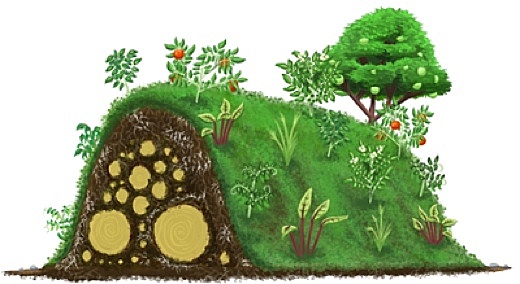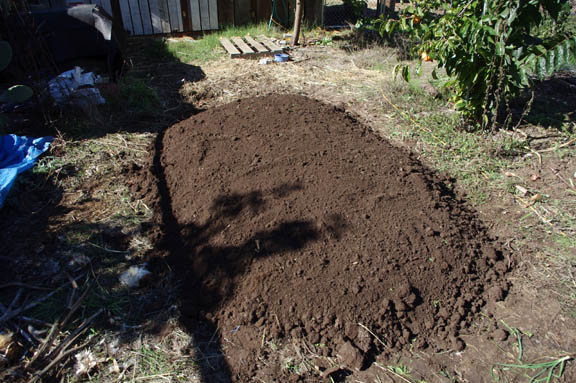SUBHEAD: How to enrich your garden soil by creating a raised Hugelkultur Bed.
By Rachel of Dog Island Farm on 14 November 2012 for HomeGrown -
(http://homegrown.org/blog/2012/11/themakingofahugelkulturebed/)

Image above: Cross section of hugelkultur mound. From video below.
Oh yes, I’m going to be talking a lot about hugelkultur beds because we just finished our first small 10′ section of it this afternoon. While it didn’t take very long to do, it was a lot of heavy lifting. Most of the work was actually clearing out the bed of raspberries (that never have produced a single berry) and weeds and then digging a foot of dirt out.

Building a hugelkultur bed doesn’t actually require you to dig up the dirt and sink it, but what can I say? We’re gluttons for punishment? No, actually, our soil has been so nicely amended and had this great texture that we decided to dig it out so we can add it back to the top of the hugelkultur bed. And in the past when we used to do raised beds we always found that when we included native soil in the beds they always did a lot better. My guess is that the native soil includes micronutrients and microorganisms that compost doesn’t have.

We then laid down sheets of cardboard. Of course, this is another step you don’t have to do but because we have such a problem with bindweed (which can have viable roots as far down as 20′) we decided that putting down cardboard would create a barrier to help stop the bindweed but eventually break down once it was no longer needed. Once the cardboard was down we started tossing wood of various sizes onto the pile. and a few old artichoke stalks for good measure. The wood is the key to hugelkultur.
While it breaks down over time it will absorb water like a sponge while also releasing nutrients. The water absorption helps reduce your water use. If you make large 6′ tall beds you can go without adding any additional water during dry summers. Since our bed is not that high we’ll still have to supplement with summer water but we can definitely cut back since a bed that’s only 2′ tall can hold water for approximately 3 weeks.
This leads to another important thing about these beds. You have to build them before the rains come, which is late fall here, so they can absorb as much water as possible before you can plant them. It’s best to use rotting wood which will hold more water and is also less likely to tie up nitrogen in the soil. Also avoid certain woods such as black walnut, cedar, redwood, black locust and eucalyptus which either contain rotting inhibitors or contain compounds that are toxic to other plants. Fruit tree wood also has a tendency to be too hard and take too long to start rotting.

After we got all the wood in place we placed a good thick layer of poultry litter which consists of straw with chicken and turkey manure and quite a few feathers (just because they are currently molting). Poultry litter is the best way we’ve found to get a compost pile up and running quickly so we wanted to use this directly on the logs to help get the breakdown process started. Again, this isn’t necessarily a step you must do to build a traditional hugelkultur bed, it’s just a step we chose to do.

Another step we chose to include was to cover the poultry litter with finished compost that we picked up at the local recycling/composting facility. $4.31 for a truckload, which you just can’t beat.

The final layer, which is really the only other thing you have to do besides using wood, is covering the bed with soil and smoothing it out. Yes, it’s a lot of work but the work we do now means we won’t have to work later. Hugelkultur beds are kind of self-tilling and since they are raised they’ll never get walked on, which compacts the soil.
We’ll definitely finish off this one bed, hopefully getting more of it done tomorrow and then we can start thinking about doing some of the other larger beds. Eventually if this works out for us, I’d like to do all of our beds this way.
Video above: 'Hugelkultur Beds: The ultimate raised garden". From (http://youtu.be/Sso4UWObxXg).
.
By Rachel of Dog Island Farm on 14 November 2012 for HomeGrown -
(http://homegrown.org/blog/2012/11/themakingofahugelkulturebed/)

Image above: Cross section of hugelkultur mound. From video below.
Oh yes, I’m going to be talking a lot about hugelkultur beds because we just finished our first small 10′ section of it this afternoon. While it didn’t take very long to do, it was a lot of heavy lifting. Most of the work was actually clearing out the bed of raspberries (that never have produced a single berry) and weeds and then digging a foot of dirt out.

Building a hugelkultur bed doesn’t actually require you to dig up the dirt and sink it, but what can I say? We’re gluttons for punishment? No, actually, our soil has been so nicely amended and had this great texture that we decided to dig it out so we can add it back to the top of the hugelkultur bed. And in the past when we used to do raised beds we always found that when we included native soil in the beds they always did a lot better. My guess is that the native soil includes micronutrients and microorganisms that compost doesn’t have.

We then laid down sheets of cardboard. Of course, this is another step you don’t have to do but because we have such a problem with bindweed (which can have viable roots as far down as 20′) we decided that putting down cardboard would create a barrier to help stop the bindweed but eventually break down once it was no longer needed. Once the cardboard was down we started tossing wood of various sizes onto the pile. and a few old artichoke stalks for good measure. The wood is the key to hugelkultur.
While it breaks down over time it will absorb water like a sponge while also releasing nutrients. The water absorption helps reduce your water use. If you make large 6′ tall beds you can go without adding any additional water during dry summers. Since our bed is not that high we’ll still have to supplement with summer water but we can definitely cut back since a bed that’s only 2′ tall can hold water for approximately 3 weeks.
This leads to another important thing about these beds. You have to build them before the rains come, which is late fall here, so they can absorb as much water as possible before you can plant them. It’s best to use rotting wood which will hold more water and is also less likely to tie up nitrogen in the soil. Also avoid certain woods such as black walnut, cedar, redwood, black locust and eucalyptus which either contain rotting inhibitors or contain compounds that are toxic to other plants. Fruit tree wood also has a tendency to be too hard and take too long to start rotting.

After we got all the wood in place we placed a good thick layer of poultry litter which consists of straw with chicken and turkey manure and quite a few feathers (just because they are currently molting). Poultry litter is the best way we’ve found to get a compost pile up and running quickly so we wanted to use this directly on the logs to help get the breakdown process started. Again, this isn’t necessarily a step you must do to build a traditional hugelkultur bed, it’s just a step we chose to do.

Another step we chose to include was to cover the poultry litter with finished compost that we picked up at the local recycling/composting facility. $4.31 for a truckload, which you just can’t beat.

The final layer, which is really the only other thing you have to do besides using wood, is covering the bed with soil and smoothing it out. Yes, it’s a lot of work but the work we do now means we won’t have to work later. Hugelkultur beds are kind of self-tilling and since they are raised they’ll never get walked on, which compacts the soil.
We’ll definitely finish off this one bed, hopefully getting more of it done tomorrow and then we can start thinking about doing some of the other larger beds. Eventually if this works out for us, I’d like to do all of our beds this way.
Video above: 'Hugelkultur Beds: The ultimate raised garden". From (http://youtu.be/Sso4UWObxXg).
.
No comments :
Post a Comment